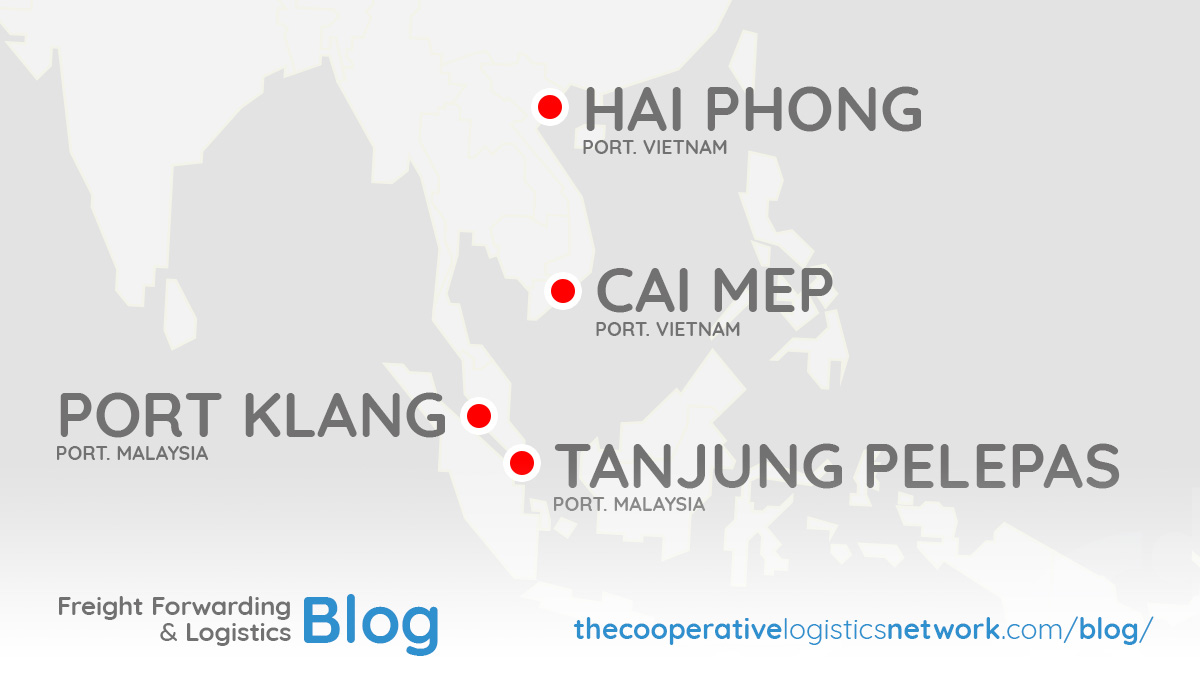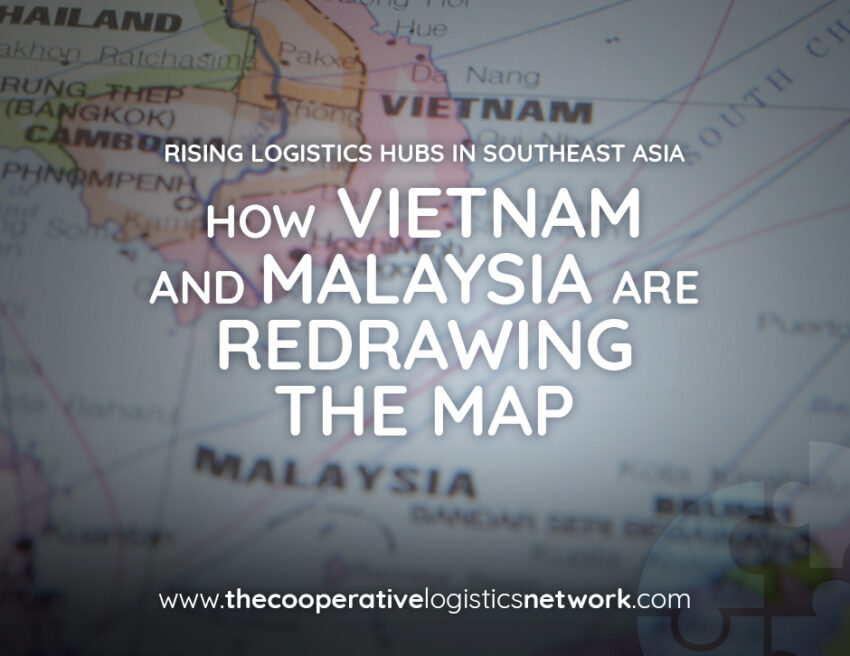For years, Singapore has been the uncontested kingpin of maritime trade in Southeast Asia. But look a little closer, and you’ll see a shift underway. Vietnam and Malaysia are now investing heavily in port infrastructure, trade facilitation, and regional connectivity. As shipping routes evolve and demand grows, new logistics hubs in Southeast Asia are emerging fast, redrawing the region’s freight forwarding landscape.
This shift isn’t just about national pride or regional competitiveness. It reflects deeper changes in global supply chains, particularly as manufacturers diversify away from China and look for faster, more cost-effective alternatives. Vietnam and Malaysia are seizing this moment, offering capacity, efficiency, and strategic access to vital trade corridors.
Vietnam: From manufacturing magnet to maritime contender
Vietnam’s transformation from an agriculture-based economy to a manufacturing powerhouse is well documented. What’s changing now is its maritime muscle. Key ports like Cai Mep-Thi Vai and Hai Phong are no longer just local gateways; they’re becoming major nodes in global shipping networks.
Cai Mep, for instance, is one of the few ports in Southeast Asia capable of handling ultra-large container vessels (ULCVs). It’s already drawing direct services to Europe and North America, bypassing traditional transshipment hubs like Singapore or Hong Kong. With increasing investments in automation, dredging, and road-rail connectivity, Vietnam’s port infrastructure is catching up fast with its booming export economy.
Vietnam’s strategic location along vital east-west and north-south shipping lanes adds to its appeal. International shipping companies are expanding their presence here, betting on continued growth in container shipping. Freight forwarders are finding that container shipping in Vietnam is no longer a secondary option but a primary gateway to key markets.

Malaysia: The quiet logistics giant of the region
While Vietnam is often seen as the rising star, Malaysia is quietly but steadily building one of the most advanced logistics ecosystems in the region. Port Klang and Tanjung Pelepas are leading the charge. Both are among the top 20 busiest container ports in the world, and both are undergoing aggressive expansion.
Port Klang is positioning itself as a regional transshipment hub, handling traffic not just from Malaysia but also from neighboring Indonesia, Thailand, and even parts of the Indian subcontinent. Its Free Commercial Zone status and deepwater capabilities make it especially attractive for large shipping lines and global freight forwarders.
Meanwhile, Tanjung Pelepas offers direct access to major sea lanes and has built a reputation for high efficiency and low congestion. Located near the Singapore Strait, it benefits from proximity to one of the world’s busiest maritime corridors without the high operating costs associated with Singapore.
Beyond ports, Malaysia is investing in multimodal connectivity. New road, rail, and airport links are tightening the integration between inland industrial zones and port terminals. This is a critical move that transforms Malaysia’s ports from standalone facilities into full-fledged logistics hubs in Southeast Asia.
Logistics hubs in Southeast Asia: redefining the regional supply chain
The rise of Vietnam and Malaysia as logistics hubs in Southeast Asia is not happening in isolation. It’s part of a broader trend across the ASEAN region to diversify trade routes, modernize infrastructure, and reduce reliance on legacy ports. For freight forwarders, this means more routing options, better turnaround times, and often, reduced costs.
Vietnam’s northern ports like Hai Phong are serving as entry points for trade with southern China. At the same time, southern ports like Cai Mep are connecting directly to Europe and the Americas. This dual-axis strategy opens new lanes for cargo movement, especially for industries like textiles, electronics, and machinery.
In Malaysia, port development is closely tied to free trade zones and industrial parks. Port Klang’s integration with Klang Valley’s manufacturing belt, for example, gives it a unique edge in serving just-in-time supply chains. Tanjung Pelepas’ efficiency and scalability are making it an attractive alternative for cargo that would have traditionally gone through Singapore.
This shift is also supported by strong government backing. Both countries have national logistics master plans that prioritize port expansion, customs modernization, and digital trade facilitation. These policies are designed to make their ports not just bigger, but smarter and more responsive to the needs of global trade.
Why freight forwarders should pay attention
For independent freight forwarders, the implications are clear. The emergence of new logistics hubs in Southeast Asia creates opportunities to diversify routes, tap into faster-growing markets, and build new carrier relationships.
Capacity constraints and rising costs at legacy hubs make alternatives like Cai Mep or Port Klang more appealing. These ports offer competitive pricing, ample space, and increasingly sophisticated infrastructure. And with the rise of digital freight platforms and port community systems, coordination is getting easier. More importantly, customers are beginning to ask smarter questions. They want transparency, speed, and sustainability. Freight forwarders who can offer routing through newer, more efficient Southeast Asian ports are well-positioned to win that business.
Joining the Cooperative Logistics Network: Expanding reach through global partnerships
For freight forwarders in Southeast Asia seeking to capitalize on these emerging logistics hubs, joining the Cooperative Logistics Network can be a game-changer. With access to over 370 carefully selected independent freight forwarders across more than 134 countries, members gain immediate global reach and trusted local partners. This level of international connectivity allows forwarders to move cargo more efficiently, tap into new markets, and collaborate on cross-border projects with confidence. For companies operating out of Vietnam and Malaysia, it means leveraging their strategic position with the strength of a global network behind them.
Looking ahead: What to expect in 2025 and beyond
The momentum is real. Trade volumes through Vietnam and Malaysia are rising steadily. Infrastructure investments are continuing, even in the face of global economic uncertainty. And partnerships with major international port operators are helping bring in best practices and technology.
We can expect Vietnam to continue developing deepwater ports and inland depots, especially in the central region to balance the north-south divide. Malaysia, on the other hand, is likely to double down on its role as a transshipment and multimodal logistics center for the wider ASEAN and Asia-Pacific region.
For freight forwarders, keeping a close eye on these developments isn’t optional. The balance of power in Asian logistics is shifting. Ports that were once seen as alternatives are now becoming preferred choices. And the smart players in the logistics game are already adjusting their strategies.
Final thoughts
The rise of Vietnam and Malaysia as logistics hubs in Southeast Asia marks a turning point for the region. It reflects not just infrastructure upgrades but a fundamental rethinking of trade flows, supply chain management, and port competitiveness.
As freight forwarders adapt to these changes, those who embrace the new geography of trade will find themselves better equipped for growth, resilience, and relevance in the years ahead.


